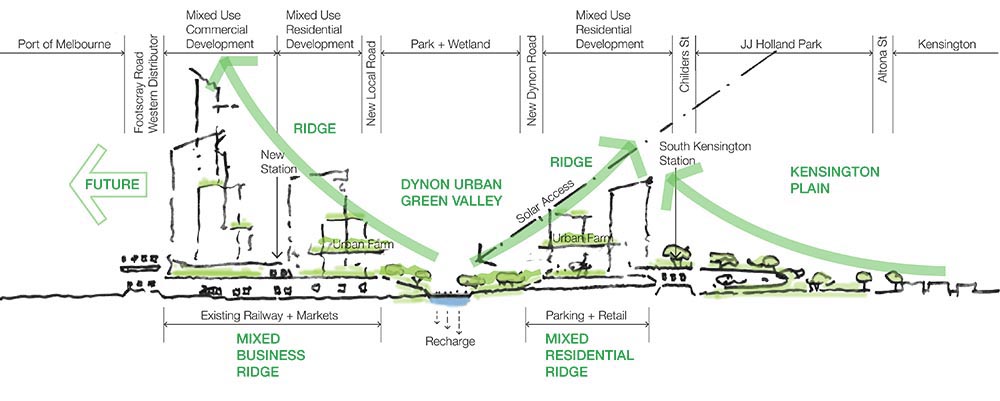CM+ teamed up with Tract’s Sydney office and Farrells Melbourne and Hong Kong offices to provide a competition entry for ‘The Future Park Design Ideas Competition’ presented by the University of Melbourne, in partnership with the Australian Institute of Landscape Architects (AILA). The aim of the competition brief was to create a new piece of open space that would change the direction of urban development in Melbourne.
The team developed the design through a series of international workshops and submitted the entry under the heading of ‘Melbourne Dynon Valley 2050’.
Dynon Creek runs west of the Melbourne CBD and formed the spine for a new open space and urban district that would become a new part of Melbourne. The concept grew from an idea of the landscape as the foundation for urbanism, built on an integrated place based approach to natural systems – water, energy, flora and fauna habitat – and recognises that humans share this place with many other living things.
Why Dynon Creek area?
- Melbourne is growing westward but is disconnected from its western green system
- Using both Dynon Creek and the nearby railway as new green spines creates green spaces with both local and regional impacts that bridge this gap
- It merges open space and development to provide a new urban area, home to 61,000 people, leveraging 110 hectares of green space and 30,000 new trees to connect:
- across waterways
- through the city
- the CBD and Flemington
- metropolitan Melbourne.

What does a park in the 21st century in Melbourne need to do?
- Acknowledge that green infrastructure is a system across the city
- Recognise that green networks are not just for people, but provide connectivity for water, animal and plant communities
- Provide for restoration and rewilding
- Celebrate the culture of Melbourne and its ‘4 Seasons in 1 Day’ narrative
- Embrace solutions that merge built form with landscape for production and recreation
- Understand that ecology and the city is a singular three dimensional eco-system.
How will the park acknowledge this place?
- Ecological – An understanding the original ecosystem overlaid with a productive landscape; a place of refuge for fauna and people. An urban forest and waterway from Moonee Ponds Creek to the Maribyrnong River.
- Aboriginal – An ecologically restorative and balanced environment that maximizes strong physiological, cultural and spiritual connection with nature.
- Social – A new transit line and a web of active transport create easy accessibility within the city. The all season multi-use landscape, a topography of ridgelines and valleys, encourages activity and provides viewing platforms for engagement.
- Functional – The park and its neighbourhoods have a legible structure that provides a hierarchy of multifunctional places integrated into the everyday life of Melbourne.
- Sustainable – The biorhythms of the park support a carbon neutral outcome with recycled water and biomass loops that reach into the surrounding neighbourhoods with interconnected urban farms.
The entry was shortlisted and exhibited, as part of the AILA National Conference held in Melbourne, from 4 October to 1 November 2019 at the Dulux Gallery, Glyn Davis Building, Parkville Campus, University of Melbourne and noted in an article about the exhibition on October 29, 2019 by ‘The Age’.
